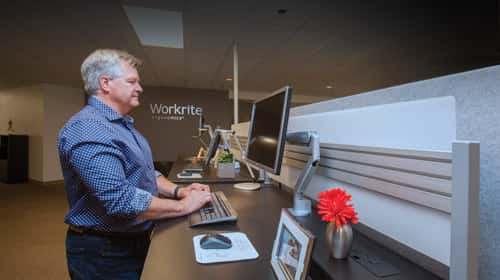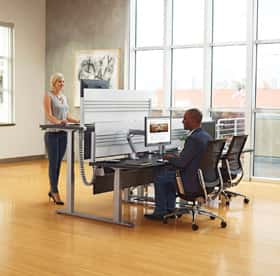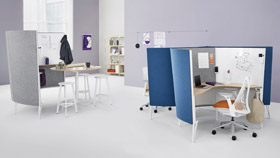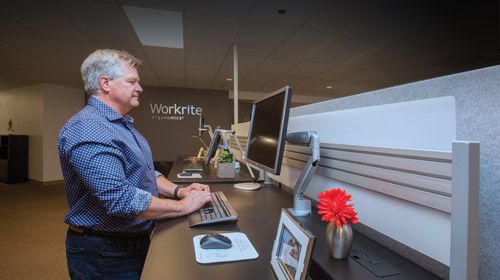
Americans spend plenty of time on the job. From tech engineer to CEO, accountant to graphic designer, those working the usual nine to five spend plenty of time on the job. All of us deserve a workplace that fits. A typical scenario, say 40 hours a week (with no overtime and two weeks vacation) results in 2,000 hours a year, or 22.8 percent of someone’s life, transpiring at work. If some of that time is spent in pain resulting from the office environment such as computer-related eye strain, back pain or carpel tunnel syndrome—overwork can transform into outright disability. Even minor complaints can result in fatigue, dangerous loss of alertness and decreased productivity.
A company’s ability to attract quality personnel now includes more than a competitive salary and benefits; it means providing employees a more enjoyable and healthier space. Enter workplace ergonomics.
Ergonomics is the applied science concerned with designing and arranging things people use so that the people and things interact most safely and efficiently. We often hear the term in relation to placement of computer monitors at the proper eye level, chairs with lumbar back support, desks that can be adjusted for sitting or standing, and keyboard trays constructed to prevent wrist injuries. Occupational environments are also at risk for injuries resulting from bending, lifting heavy objects (especially overhead), sitting for long periods, or standing with slumped posture.
OSHA reports that work-related musculoskeletal disorders (MSDs) are responsible for 34 percent of all lost workdays, resulting in $20 billion a year in direct costs and $1 out of every $3 spent on Workers Compensation. That’s enough to make any employer take notice, and many are.
 “Ergonomic solutions are not a luxury anymore, they’re becoming ubiquitous,” says Tom Fritz, senior director of marketing and product development at Workrite, a manufacturer of ergonomic products with a facility in Petaluma. “For the contemporary facilities manager, it’s becoming the standard way to do business. You increase productivity by enhancing the employee’s comfort and safety.”
“Ergonomic solutions are not a luxury anymore, they’re becoming ubiquitous,” says Tom Fritz, senior director of marketing and product development at Workrite, a manufacturer of ergonomic products with a facility in Petaluma. “For the contemporary facilities manager, it’s becoming the standard way to do business. You increase productivity by enhancing the employee’s comfort and safety.”
Fritz says a substantial portion of Workrite’s sales are sit-stand desks. “In the past, keyboard platforms and multi-monitor mounts were exceptionally popular. The company has been in business since 1991, but in the last few years, the sit-stand desk market has been hot. You can sit when you’re tired, stand when you want to. Workrite sit-stand desks adjust easily and operate quietly with control systems and power sources that operate at a decibel level below anything that would be disruptive.”
It’s not just complete desks, but components such as custom sized and shaped laminate worktops that are part of Workrite’s manufactured solutions for their business-to-business clients. “You could say another workplace trend is customization, whether a client is retrofitting or starting a new office from scratch,” continues. “First you want everyone to be comfortable and ergonomically right. Next you want to help them create their vision for the space. And what follows along with custom design and comfort is a more flexible environment, with multiple configurations and room for collaboration.”
The living office
Trope Group is a provider of workplace business solutions and services to the communities of Sonoma, Marin, Napa, Solano, Mendocino and Lake counties. The company, founded in 1980, represents some of the most innovative manufacturers of open plan and conventional office furniture, and is the sole authorized Herman Miller dealer located in the North Bay. The Trope team helped Keysight Technologies get 800 employees up and running in Rohnert Park while the Santa Rosa facility was being repaired (mostly from smoke damage) after the October fires.
 When a visitor steps through the door of the Trope Group office and showroom on Circadian Way in Santa Rosa there is no “lobby” or reception desk. The open space is full of light, texture and color, with areas organized in conversational groups, high and low conference tables, audio/visual areas, and sleek workstations with myriad combinations of adjustable desks and computer monitors. As principal Charlie Nicholls tells it, their internal process in designing this space to suit the company’s values and intent was the same process they facilitate for their clients.
When a visitor steps through the door of the Trope Group office and showroom on Circadian Way in Santa Rosa there is no “lobby” or reception desk. The open space is full of light, texture and color, with areas organized in conversational groups, high and low conference tables, audio/visual areas, and sleek workstations with myriad combinations of adjustable desks and computer monitors. As principal Charlie Nicholls tells it, their internal process in designing this space to suit the company’s values and intent was the same process they facilitate for their clients.
“Living Office is a Herman Miller-developed program that helps a business or company to uncover what are the most important business drivers for that specific organization,” Nicholls explains. “We use that information to develop the types of work settings that support those goals the company wants to move toward, supporting and empowering their employees.”
This concept is illustrated graphically in 2-inch-high black lettering on the wall just to the left of Trope’s entrance: Living Office helps people customize their methods, tools, and places of work and purpose. It is a more natural and desirable workplace that fosters greater connection, creativity, productivity and ultimately greater prosperity for all.
Telecommuters have demonstrated the clear advantages of working from home; what companies are trying to do now is create a workplace that is more like home, that is, one that is friendly, relaxed, open and comfortable. The intent is to balance the creative ease of an individual working at home with an office community that is bustling, dynamic, involving multiple generations and fostering more interchange. The office provides communal access to extensive resources, space and expertise but also the feeling of being a team, or a family.
Nicholls says that the younger generation of workers is used to being ‘connected’ and functioning within a variety of settings. “Sometimes you want to be alone, focused, quiet and concentrated, and sometimes you want to have brainstorming sessions, work in small groups, or convene a presentation or training session for a larger audience,” he says. “As companies have become more global, teams find they are video conferencing with colleagues on the other side of the world. All these uses must operate seamlessly. Technology is the common denominator integrated into the spaces and into the furniture.”
One example of such integration is the Aeron chair, which contains sensors that allow the user to set preferences for sitting and standing to move comfortably between the two throughout the day. “This is something people are used to now like setting your Apple watch to prompt you to breathe,” Nicholls says.
Holistic solutions may not succeed without feedback, planning and buy-in. Nicholls notes that some early adapters, in their excitement, may have imposed innovations from the top, resulting in push-back. This is when Trope Group can coach clients through a specific living office process that helps companies call in their people from all sectors to articulate the core of what they value, what they want, and how they plan to achieve it.
“There is a lot going on locally,” Nicholls says. “Everyone is in a different spot, but if you’re a technology company, you must adapt faster. We also have banking and finance customers who are working very hard to support their employees. Everything eventually will come down to cost, so change does come incrementally, with the most important expressed needs implemented first. Then each time you move into a new space, you can push the envelope more.”
The ergonomics advantage
 Ergonomic success depends on how proactive businesses are about the health and safety of their employees, whether that involves addressing a pain complaint in a timely manner, or starting off a new hire with an appropriate chair and equipment. Enlightened managers and department heads often turn to experts. Robert B. Niklewicz, P.T., DHSc CEAS II CIE, is one of those experts, an ergonomist, known as “Dr. Bob.” A physical therapist and national instructor with “The Back School,” Niklewicz has lectured and consulted in Ergonomics since 1993, and has taught at the University of California, San Francisco; San Francisco State University; and the Santa Rosa Junior College. He provided physical therapy services and ergonomics assessments to many North Bay companies including State Farm Insurance, Medtronic, Agilent and entities such as the County of Sonoma and the U.S. Coast Guard.
Ergonomic success depends on how proactive businesses are about the health and safety of their employees, whether that involves addressing a pain complaint in a timely manner, or starting off a new hire with an appropriate chair and equipment. Enlightened managers and department heads often turn to experts. Robert B. Niklewicz, P.T., DHSc CEAS II CIE, is one of those experts, an ergonomist, known as “Dr. Bob.” A physical therapist and national instructor with “The Back School,” Niklewicz has lectured and consulted in Ergonomics since 1993, and has taught at the University of California, San Francisco; San Francisco State University; and the Santa Rosa Junior College. He provided physical therapy services and ergonomics assessments to many North Bay companies including State Farm Insurance, Medtronic, Agilent and entities such as the County of Sonoma and the U.S. Coast Guard.
There’s a reason his business is titled ERGOCATION—a combination of ergonomics and education. “The more ergonomic education you receive about ergonomic risks and the best way to sit, stand, reach, lift and bend, the better chance you have to avoid fatigue and injury,” he says. Though he has spent many years rehabilitating injured workers, his main priority these days is educating employees on prevention strategies.
When Niklewicz is called in on a consultation, he first must understand the situation—what is the work and how is the employee performing the job? “This is an individual business; every body is different,” he says. “If it’s a new employee, I start from the ground up, trying to get the individual into what I call a relaxed, neutral posture. I look at ankles, knees and hips, back, shoulders, arms and neck. Is the chair back pitched for their particular anatomy and supportive so that muscles feel the confidence to relax? As I go along, I explain what I’m doing and why, so that the person understands and can take responsibility to continue ergonomic awareness for themselves.”
When called in to consult on an injury case, Niklewicz considers the possible sources of the discomfort, and adjusts the workstation to eliminate possible ergonomic risk factors that may cause leg pain, numbness of hands, backaches and headaches. With his background in physical therapy, he thoroughly understands the physiology and can often “reverse engineer” to get to the source of the problem. “Hand pain can come from the elbow, or other parts of the body you might not suspect at first,” he says. With workers outside the office—warehouse and assembly line or maintenance workers—the complaints and injuries are a result of “postural issues, repetition and dealing with force.” In each case, the source needs to be corrected. “All the trips to doctor, chiropractor or physical therapist won’t help for long if the individual keeps going back to the same situation,” he adds.
Retrofitting a whole facility can be slow and expensive. For businesses with tight budgets, Niklewicz offers this advice, “Go for the low-hanging fruit: providing education in basic ergonomics as well as fitting the equipment to the worker, not the other way around. A well-fitting keyboard, monitor, mouse and lights can prevent problems before they happen,” he says. There’s some truth to the phrase “sitting is the new smoking,” according to Niklewicz. “But the point is, you have to have the discipline to get out of the chair to promote circulation and avoid fatigue. It’s all about changing human behavior.”
Get up stand up
 A human being is not designed to spend hours hunched up on a seat, looking at screens and talking on the phone. Prolonged sitting is enough to shut down the enzymes responsible for improving cholesterol, and for regulating blood sugar. Lack of these enzymes will contribute to weight gain, diabetes and a reduction in HDL— the good cholesterol. After two hours of sitting, HDL levels can drop 20 percent; enzymes in the blood that burn fat drop 90 percent.
A human being is not designed to spend hours hunched up on a seat, looking at screens and talking on the phone. Prolonged sitting is enough to shut down the enzymes responsible for improving cholesterol, and for regulating blood sugar. Lack of these enzymes will contribute to weight gain, diabetes and a reduction in HDL— the good cholesterol. After two hours of sitting, HDL levels can drop 20 percent; enzymes in the blood that burn fat drop 90 percent.
A 2013 survey of 30,000 women, reported in the American Journal of Preventive Medicine, found that those who sat nine or more hours a day were more likely to be depressed than those who sat fewer than six hours. Prolonged sitting reduced circulation to the brain, hurting creativity and mood. Other studies indicate that too many hours in your office chair or on the couch in front of the TV may well shorten your life. To prevent discomfort, fatigue and other long-term health problems, consider the following:
When standing, adjust the height of your work surface to allow activity without reaching or bending; keep forearms parallel to the floor and at a 90-degree angle to upper arms; let wrists, neck, and head stay in a relaxed neutral position. The computer should be 15 inches (or arm’s length) from the eyes, with the top one-third of the screen positioned at or below eye level. The same guidelines go for sitting, although the chair seat should allow you to keep your feet firmly on the floor (no crossed legs); use a footrest if your feet don’t feel supported. Your knees should extend beyond edge of seat, with thighs approximately parallel to floor.
Slouch no more
Maintaining good posture is another way to avoid musculoskeletal injuries, which, according to OSHA, account for 34 percent of all lost workdays reported to the Bureau of Labor Statistics. A properly aligned spine (head aligned over pelvis, shoulders rolled down and back) takes pressure off muscles and ligaments. A properly aligned spine (head aligned over pelvis, shoulders rolled down and back) takes pressure off muscles and ligaments. Good posture also facilitates breathing and improves digestion; an increase of energy follows. Besides improving wellness, conscious body language has other benefits for business professionals. An erect, chin-up stance helps communicate confidence and competence, a sense of “owning the room.” Slouching makes one look tired, fearful or self-conscious. That hard-earned wardrobe fits better, and the wearer projects a stronger, more vibrant appearance to colleagues and customers.
Lighting
The benefits of daylight, as those with season affective disorder well know, are energizing and uplifting. Lighting is ergonomic and affects the well-being of workers. Eye fatigue and headaches resulting from near-continuous use of monitors can be prevented by using diffused light instead of a single source and being aware of how positioning of desks relative to window light can mitigate screen glare. If lighting is geared toward the individual and the task, it can also have an effect on the bottom line. Many companies have overhead lighting systems that are much brighter than recommended levels. In those instances, applying proper lighting to specific locales helps reduce overall energy costs.
A fascinating new trend using LED lights that adapt to human biorhythms for working and resting was recently reported in The New York Times. In “These Lights Are Like a Mood Ring for Your Room,” Tom McKeough describes “circadian lighting” that “aims to keep the body’s internal clock aligned with the 24-hour diurnal/nocturnal cycle by emitting bright bluish light during the day to suppress the melatonin that our brains produce as a natural sleep aid. As evening approaches the system switches to dim yellowish light, allowing the hormone to flow freely.” The article also noted, “One piece of evidence to support the technology is that employees no longer unscrew bulbs from ceiling fixtures or amass piles of their own lamps to create comfortable lighting at their desks.”
Promoting healthier workplaces
Workplace wellness programs have been around for a while, but they have evolved. The extent to which the best modern employers go to promote “work-life balance” (and to help alleviate pressure from ever-tightening deadlines) include: meditation, nap rooms, physical therapy and massage, in-house culinary teams cooking from on-site organic gardens, lunchtime walking groups, community bikes, free gym memberships, Zumba classes and weight-loss challenges.
 “Keep it moving” and “Sit less, stand more” are two slogans of the wellness program at Workrite Ergonomics. Workrite’s newcomer swag bag has among its generous contents a mouse pad imprinted with “Seated exercises you can do at work,” a fidget spinner (company logo emblazoned), and a coloring book with crayons that sends the message, taking a break means just that. Employees can earn cash credit for up to $250 for amassing “wellness points” for getting a vision exam, attending a Lunch & Learn, logging walking miles and more. Workrite president Charlie Lawrence writes that financial investment in his workers’ well-being “has produced immeasurable results in employee engagement and happiness.”
“Keep it moving” and “Sit less, stand more” are two slogans of the wellness program at Workrite Ergonomics. Workrite’s newcomer swag bag has among its generous contents a mouse pad imprinted with “Seated exercises you can do at work,” a fidget spinner (company logo emblazoned), and a coloring book with crayons that sends the message, taking a break means just that. Employees can earn cash credit for up to $250 for amassing “wellness points” for getting a vision exam, attending a Lunch & Learn, logging walking miles and more. Workrite president Charlie Lawrence writes that financial investment in his workers’ well-being “has produced immeasurable results in employee engagement and happiness.”
Open-architecture spaces, complete with pop-up conference rooms and “smart” chairs, are being designed to enrich and streamline our working lives. Along with promoting the efficiency and vitality of these shiny new environments, many companies and organizations are adapting the highest standards for safety, sustainability and durability with innovative ergonomic solutions that benefit all employees, “fitting the work to the worker” and not the other way around.





